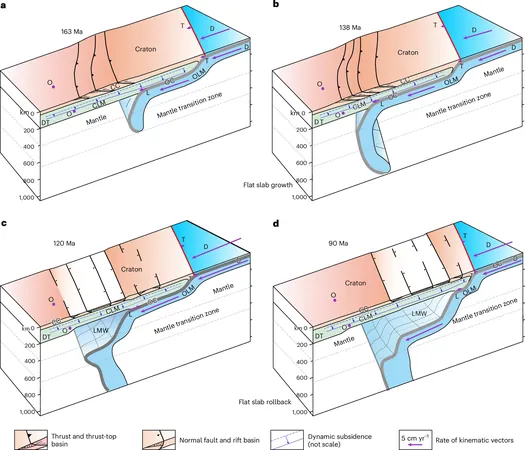
Earth's Oldest Continental Crust Faces Dramatic Disintegration – What It Means for Our Planet
2024-10-08
Author: Nur
Introduction
Recent research reveals alarming insights into the fate of Earth's ancient continental crust, suggesting that even the oldest and most stable regions are not immune to the forces of tectonic activity. Over billions of years, the configurations of continents have evolved significantly, shaped by processes including plate tectonics, mantle convection, and the slow dance of geological time. Among these age-old formations are cratons—areas of continental crust known for their long-term stability and low tectonic activity.
Groundbreaking Study on Decratonization
A groundbreaking study, published in *Nature Geoscience*, explores the mechanisms leading to a phenomenon called decratonization, where these ancient cratons undergo deformation and eventual disintegration. This research focuses specifically on the North China Craton (NCC), off the western Pacific Ocean, traversing a timeframe of around 200 million years, effectively capturing dramatic geological transformations from the Mesozoic era.
Research Methodology
Under the leadership of Professor Shaofeng Liu from the China University of Geosciences, the study employs advanced four-dimensional mantle flow models to track changes in the NCC's lithosphere—the rigid outer layer comprising the crust and upper mantle. This model considers various data points, including seismic tomography, which visualizes the Earth's interior using seismic wave data.
Key Findings
Interestingly, the research identifies two critical phases in the transformation of the NCC. The first, marked by the subduction of the Izanagi Plate (a lower density oceanic plate), caused the Eurasian Plate, which the NCC sits upon, to thicken and rise, forming significant topographical features such as the Taihang Mountains.
However, the story doesn't end there. Following this initial phase, there was a rapid rollback of the subduction zone, which led to significant thinning of the lithosphere—by an astonishing 26%. Over the course of millions of years, geologists observed various fault activities, including thrust faults where older geological layers were forcibly raised above younger ones.
Broader Implications
Moreover, the study showcases how these decratonization processes don't just signify local changes but hint at broader patterns witnessed across various cratons worldwide. Regions like the North American and South American cratons, as well as China’s Yangtze craton, may have experienced comparable deformation—albeit under different conditions, presenting a fascinating comparison in continental dynamics.
Conclusion
In a striking conclusion, Professor Liu emphasizes that this research underscores a critical geological truth: ancient lithospheres can fracture, and their breakdown is often linked to subduction mechanics near oceanic plates. This revelation not only enriches our understanding of how continents evolve but also poses significant questions about the stability of continental interiors compared to those nearer to tectonic borders, which might be more susceptible to geological upheaval.
As scientists continue to explore the nuances of cratonic evolution, the implications of this research are profound, shedding light on Earth's intricate geological history and offering clues about the planet's future. What's next for the cratons around the globe, and how might these changes influence our understanding of seismic activity and continental stability? The answers are as intriguing as they are essential in anticipating Earth's geological trajectory.




 Brasil (PT)
Brasil (PT)
 Canada (EN)
Canada (EN)
 Chile (ES)
Chile (ES)
 España (ES)
España (ES)
 France (FR)
France (FR)
 Hong Kong (EN)
Hong Kong (EN)
 Italia (IT)
Italia (IT)
 日本 (JA)
日本 (JA)
 Magyarország (HU)
Magyarország (HU)
 Norge (NO)
Norge (NO)
 Polska (PL)
Polska (PL)
 Schweiz (DE)
Schweiz (DE)
 Singapore (EN)
Singapore (EN)
 Sverige (SV)
Sverige (SV)
 Suomi (FI)
Suomi (FI)
 Türkiye (TR)
Türkiye (TR)